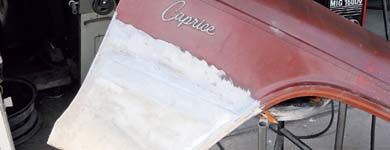
Restoring a rusted hulk of a hot rod is, to us folks out here in sunny SoCal anyway, by no means a gargantuan task. Here in the land of 50-degree winters and bountiful sunshine, project cars are relatively abundant and usually in extremely good shape-relative to the rest of the country, that is.
So, the guys thought I was nuts when they saw the overly rotted carcass I dragged home recently. Why in the world would anyone in their right mind tackle rebuilding a body that most Southwest-erners would relegate to the scrap heap without a second thought? Well, perhaps it's because I enjoy a challenge, or because I'm originally from the Northeast, and this one was an acceptable project car compared to what I'm used to restoring. The honest answer mainly centers on the fact that I'm cheap and I got the car for a song; besides, with the availability of replacement and patch panels from EMS and the like, my biggest investments in the body resto will be MIG wire, time, and elbow grease.
That said, I want to reiterate the fact that I'm by no means a bodyman-just a DIYer who's willing to try my hand at nearly any task. I mention this because some more experienced folks may tackle rot repair (and a lot of the things I do) in a different and quite possibly more professional manner, but my main objectives are to motivate my peers to give hot rod building tasks an honest try on their own. It's not rocket science, and like any other undertaking related to the hobby, practice makes perfect-and, a penny saved is a penny better used to buy something shiny.
Help From Ems
I've found by experience that any job's success greatly depends on the quality of the materials used as much as the experience of those who use 'em. In fact, to set the record straight, the patch panel shown here in the following install was kind of a shaky import item, not a high-quality American-made panel like those from EMS, and was used as an illustration because the only rotten vehicle I had handy was-gasp-a '60s car.
But, luckily for those who prefer iron of the pre-'60s era, EMS catalogs are chock-full of almost anything you'll need to restore early Fords and Chevys (from 1935-58) and their selection of extremely high-quality, American-made patch panels is extensive as heck-which is a good thing for us do-it-yourselfers.
So, without further ado, follow me out to the driveway and see what it takes for an amateur to repair a rotten fender with a fresh new preformed patch panel. And also take a look at what EMS has to offer us in the way of product selection and quality for 1935-58 Fords and Chevys.
Quality Is Key
Repairing automotive rust and/or collision damage can be a pretty time-consuming task, especially for those of us who aren't bodymen by trade. But you can rest assured that the majority of panel repairs needed in our hobby really are repairable by the do-it-yourselfer. There are only a few prerequisites-most important is the willingness to give it a try. If you're willing to give it a shot on your own, all you'll need is access to and some experience with a welder, a hammer and dolly or two, and the required replacement panels.
With the first two requirements met, the third is a very important factor-using high-quality repair panels. Perhaps a good analogy would be cooking: The use of high-quality ingredients is a must for a recipe to be successful. The same holds true with rust repair. If you replace a damaged or rust-ravaged section of a body with an ill-fitting or misshapen panel, you are not going to end up with a repair that'll justify the time and effort you've expended-garbage in, garbage out, so to speak. So it's with this thought in mind that I'd like to introduce you to a company called Engineering & Manufacturing Services (EMS).
EMS is the largest American manufacturer of replacement outer-body sheetmetal for 1935-58 Chevrolet and Ford vehicles, and when we say American, we mean EMS repair panels are actually made in the good ol' U.S. of A.; they're not recycled cat food cans imported from the Pacific Rim. In fact, the company's founder started his career in the 1920s in the nation's largest Fischer Body plant four generations ago-and the family continues its forefathers' traditions of quality to this day.
So take a look at the few examples shown here of what EMS offers and keep in mind that the company catalog and Web site are full of hundreds of available panels, and they're continually adding new products to their line.